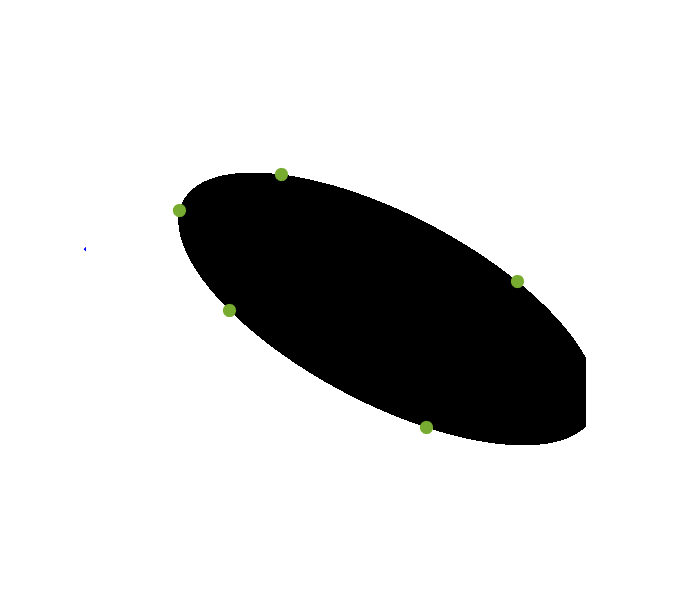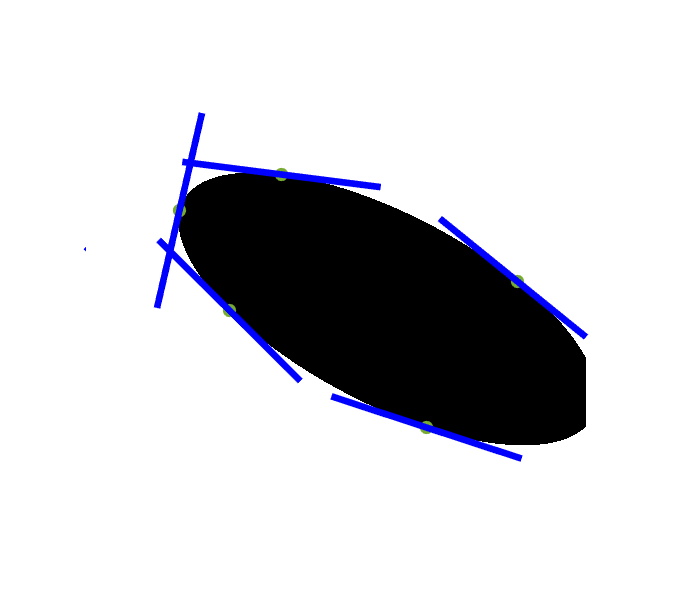Playing with conic sections in homogeneous coordinates
Contents
Preparation
First, we create an empty image and display it (will be our "canvas")
figure(1)
im=zeros(500,500);
imshow(im, []);
hold on;

Data input: enter five points (then enter)
disp('click 5 points, then enter'); [x y]=getpts; scatter(x,y,100,'filled');
click 5 points, then enter

x and y are now column vectors.
x y
x = 196.0000 432.0000 341.0000 144.0000 94.0000 y = 146.0000 253.0000 399.0000 282.0000 182.0000
Estimation of conic parameters
using the technique shown in "Multiple View Geometry", page 9. questo equivale ad impostare il sistema lineare in cui la conica passa per 5 punti
A=[x.^2 x.*y y.^2 x y ones(size(x))] % A is 5x6: we find the parameter vector (containing [a b c d e f]) as the % right null space of A. % This returns a vector cc such that A*cc=0. Note that this expresses the % fact that the conic passes through all the points we inserted. N = null(A);
A =
1.0e+05 *
0.3842 0.2862 0.2132 0.0020 0.0015 0.0000
1.8662 1.0930 0.6401 0.0043 0.0025 0.0000
1.1628 1.3606 1.5920 0.0034 0.0040 0.0000
0.2074 0.4061 0.7952 0.0014 0.0028 0.0000
0.0884 0.1711 0.3312 0.0009 0.0018 0.0000
Let's assign the values to variables and build the 3x3 conic matrix (which is symmetrical)
cc = N(:, 1); [a b c d e f]=deal(cc(1),cc(2),cc(3),cc(4),cc(5),cc(6)); % here is the matrix of the conic C=[a b/2 d/2; b/2 c e/2; d/2 e/2 f] % Remark: since the right null space has dimension one, % the system admits an infinite number of solutions % however, these can be expressed as lambda * n, where n % lambda \in R and n = null(A). % thus, they all corresponds to the same conic.
C =
0.0000 -0.0000 -0.0003
-0.0000 0.0000 -0.0044
-0.0003 -0.0044 1.0000
Draw the conic
We pick every pixel, and compute the incidence relation.
im=zeros(500,500); for i=1:500 for j=1:500 im(i,j)=[j i 1]*C*[j i 1]'; end end
Let's draw black for pixels less than zero, white for pixels greater than 0.
figure(1)
imshow(im > 0);
scatter(x,y, 100, 'filled');

N.B: if we provide only 4 points, N is a matrix
which contains in each column a generator of the null space
N = null(A(1 : 4, :)); % then, any vector living in the null space give rise to a conic % passing throguh those 4 points
Let's assign the values to variables and build the 3x3 conic matrix (which is symmetrical)
cc = N(:, 2); % cc = N(:, 1) + N(:, 2); % another example, any linear combination is fine [a b c d e f]=deal(cc(1),cc(2),cc(3),cc(4),cc(5),cc(6)); % here is the matrix of the conic C_four =[a b/2 d/2; b/2 c e/2; d/2 e/2 f]
C_four =
0.0000 0.0000 -0.0030
0.0000 -0.0000 -0.0011
-0.0030 -0.0011 1.0000
Draw the conic
We pick every pixel, and compute the incidence relation.
im_four=zeros(500,500); for i=1:500 for j=1:500 im_four(i,j)=[j i 1]*C_four*[j i 1]'; end end figure(2), imshow(im_four > 0); hold on scatter(x(1 : 4), y(1 : 4), 100, 'filled'); hold off

Tangent lines
Let's draw the tangents to our points: the tangent line in homogeneous coordinates is l the line tangent to C at the line x is defined as l = C*x
% this is the line tangent to the first point l1 = C * [x(1); y(1); 1]; % here I compute all the tangent lines simultaneously % stacking all the vectors in the columns of the matrix l l=C*[x y ones(size(x))]'
l =
0.0003 0.0019 -0.0010 -0.0019 -0.0013
-0.0025 -0.0023 0.0029 0.0019 -0.0003
0.3081 -0.2258 -0.8345 -0.2685 0.1810
in order to draw it we find its angle, then plot a line of length 200 around it. In order to write less lines of code, I'm doing a bit of hacks with matrices and vectors here: theta will be a column vector of angles, and with a single plot command I'll plot all the lines. Check out the documentation of plot to understand what's happening.
theta=atan2(-l(1,:),l(2,:)); theta = theta'; figure(1), hold on plot([x-cos(theta)*100 x+cos(theta)*100]',... [y-sin(theta)*100 y+sin(theta)*100]','b-','LineWidth',5);

Let's compute the dual conic and check that all the tangent lines we computed previously actually satisfy the relation (up to numeric precision issues).
Cstar=inv(C); l(:,1)'*Cstar*l(:,1) l(:,2)'*Cstar*l(:,2) l(:,3)'*Cstar*l(:,3) l(:,4)'*Cstar*l(:,4) l(:,5)'*Cstar*l(:,5)
ans = -2.7756e-16 ans = -2.8866e-15 ans = -1.1102e-16 ans = 7.7716e-16 ans = 6.3838e-16